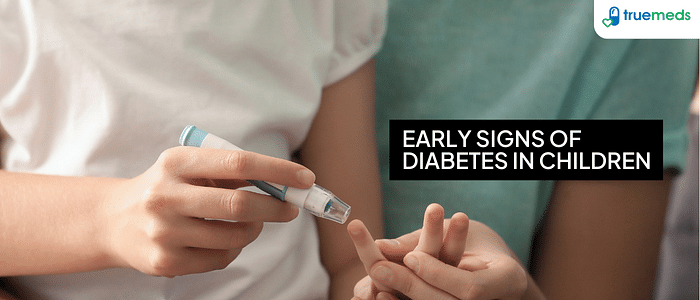Early signs of diabetes in children
Last updated on : 12 Nov, 2024
Read time : 10 min
Paediatric diabetes, including both type 1 and type 2, is an increasingly concerning condition among children. Type 1 diabetes is an autoimmune disorder where the body’s immune system mistakenly attacks the insulin-producing cells in the pancreas, halting natural insulin production. Insulin is crucial because it allows glucose (sugar) in the bloodstream to enter cells for energy. Without insulin, glucose accumulates in the blood, potentially causing serious health complications. While the exact cause remains unknown, genetic and environmental factors may contribute to its onset. Type 1 diabetes is more common in children, adolescents, and young adults.
Type 2 diabetes is more common in adults. However, this type of diabetes cases are rising among children due to obesity. It tends to develop slowly over time, and many children don’t experience any symptoms at all. In type 2 diabetes, the body becomes resistant to the insulin produced, meaning it doesn’t use insulin effectively, resulting in elevated blood sugar levels. Factors such as being overweight, a sedentary lifestyle, family history of diabetes, and pre-diabetes increase the risk of type 2 diabetes in children.
Recognising the early symptoms of diabetes in children can help in timely management. Early detection not only allows for prompt medical support but also helps better long-term management of the condition in children, reducing the risk of severe complications like nerve damage, kidney issues, and vision impairment. Let’s explore the early symptoms of diabetes in a child that can help better manage their condition.
Early signs of diabetes in children
1) Changes in Eating and Drinking Habits
Children with diabetes may experience extreme thirst, often drinking more water than usual. Despite eating enough, they might feel unusually hungry as their body struggles to manage blood sugar. This can lead to increased appetite, especially when blood sugar fluctuates drastically.
2) Weight Changes
In type 1 diabetes, children often lose weight unexpectedly even though they may eat normally or even more than usual, as their bodies can’t use sugar properly for energy. Conversely, type 2 diabetes in children, though less common, can cause gradual and excessive weight gain, often associated with lifestyle factors.
3) Frequent Urination
If your child suddenly goes to the toilet more often than usual, this could be a sign of diabetes. When blood sugar levels are high, the body tries to get rid of the excess sugar through urine, leading to frequent urination. Children may also become very thirsty because they are losing water through increased urination, which can lead to dehydration. If you notice your child frequently needing the bathroom or drinking a lot of water, it’s worth the diagnosis.
4) Extreme Tiredness or Low Energy
Extreme tiredness or feeling sluggish all the time is another symptom to look out for. When blood sugar is not properly regulated, the body can’t convert sugar into energy efficiently. This leaves your child feeling tired and lethargic. If your child seems to be tired no matter how much rest they get or if they are struggling to keep up with normal activities, this could be a sign of undiagnosed diabetes.
5) Stomach Problems
Children with diabetes, particularly type 1, may also experience stomach problems, such as nausea, vomiting, or stomach pains. These symptoms are often linked to high blood sugar or diabetic ketoacidosis. Stomach upset can occur because the body is trying to cope with the high levels of glucose in the blood. In some cases, gastrointestinal issues may be one of the first signs of diabetes, particularly in type 1 diabetes. If these symptoms occur alongside other signs, such as increased thirst or frequent urination, it’s important to consult a doctor.
6) Crankiness or Behavioural Changes
Diabetes in children can sometimes cause mood swings or behavioural changes. When blood sugar levels are too high or too low, children may feel tired, irritable, or have difficulty focusing. Parents may notice their child becoming unusually cranky or emotional, which can often be mistaken for typical mood changes. However, if these shifts in behaviour seem more pronounced or frequent than usual, they could be linked to fluctuating blood sugar levels.
7) Diaper Rash in Babies
Babies with diabetes may experience stubborn diaper rashes. Normally, a diaper rash clears up with creams and care, but high blood sugar can cause sugar to pass into the urine, irritating the skin and making it harder for the rash to heal. Suppose a baby has a diaper rash that doesn’t improve with typical treatments, combined with other unusual symptoms like increased thirst or frequent urination. In that case, it may be worth consulting further for possible signs of diabetes.
8) Blurred Vision
High blood sugar can cause temporary swelling in the eye lenses, leading to blurred or distorted vision. Children may complain about difficulty seeing clearly, squinting, or struggling to focus, which can affect their balance and coordination.
9) Tingling or Numbness
High blood sugar levels can lead to a condition known as diabetic neuropathy, which involves nerve damage. Children may report feeling “pins and needles” in their hands or feet. While less common in children, these sensations should not be ignored.
10) Slow-Healing Sores
High blood sugar also weakens the body’s healing processes, causing sores, wounds, or infections. If your child has a cut or sore that takes an unusually long time to heal or is frequently getting infections, it might be a sign of diabetes.
11) Darkened Skin Patches
Dark patches of skin, particularly in areas like the neck, armpits, and groin, are common in children with diabetes, especially type 2. This condition is known as acanthosis nigricans. It happens because of insulin resistance, where the body doesn’t use insulin properly. As a result, the body produces more insulin, which can cause the skin to darken and become thicker. While this condition is not exclusive to diabetes, it is more common in children with higher blood sugar levels. If you notice these darkened patches, it’s important to consult a doctor, as they could signal undiagnosed diabetes.
12) Fruity-Scented Breath
One of the more unusual signs of diabetes in children is a fruity smell on their breath. This can happen when blood sugar levels are very high, leading to a condition called diabetic ketoacidosis (DKA). DKA occurs when the body starts breaking down fat for energy instead of sugar, producing chemicals called ketones, which make the breath smell sweet or fruity, similar to the scent of Juicy Fruit gum.
13) Vaginal Yeast Infections in Prepubescent Girls
For young girls who haven’t yet gone through puberty, recurring yeast infections can be an early sign of diabetes. High blood sugar can create an ideal environment for yeast to grow, leading to infections that cause itching, soreness, and sometimes a white discharge. While yeast infections are more common after puberty, unusually frequent cases in younger girls could be a clue to elevated blood sugar levels, which may indicate diabetes.
Which children are at risk for type 1 diabetes and type 2 diabetes?
Children at Risk for Type 1 Diabetes
Type 1 diabetes is unavoidable, and certain factors increase the risk of this type of diabetes in children. These include:
- Genetics: If a child has a parent or sibling with type 1 diabetes, their chances of developing the condition are higher. The risk increases if multiple family members have the disease.
- Age: Type 1 diabetes is more commonly diagnosed in younger children, typically under the age of 15, though it can develop at any age.
Children at Risk for Type 2 Diabetes
Unlike type 1, type 2 diabetes is often linked to lifestyle factors. Children at risk for type 2 diabetes typically have one or more of the following risk factors. These include:
- Obesity: Overweight children are at a higher risk because excess body fat makes it harder for the body to use insulin properly. The rise in childhood obesity is a significant factor in the increasing rates of type 2 diabetes in children.
- Lack of Physical Activity: Sedentary children are more likely to develop type 2 diabetes. Regular physical activity helps the body use insulin more effectively.
- Family History: If a child has parents or siblings with type 2 diabetes, they are more likely to develop it. Genetics plays a strong role in the development of the condition.
- Age: Type 2 diabetes is more common in older children, especially in those over the age of 10, though it can affect younger children, especially in the context of obesity.
- Pre-diabetes: If a child has higher-than-normal blood sugar levels but not high enough to be diagnosed with diabetes, they may have pre-diabetes. Children with pre-diabetes are more likely to develop type 2 diabetes.
What To Do If You Notice Early Signs of Diabetes in Children?
If you notice symptoms that might indicate diabetes in your child, it’s important to seek medical advice immediately. Early diagnosis and management are key to preventing complications. Here’s what you should do if you notice any of the following signs:
1) Consult a doctor
In case of presence of symptoms such as increased thirst, frequent urination, extreme tiredness, or changes in eating habits in your child, contact your healthcare provider. Early intervention is essential for managing diabetes effectively.
2) Discuss symptoms in detail
Be ready to describe the symptoms you’ve observed, how long they’ve been present, and whether there has been any noticeable pattern.
3) Keep track of your child’s symptoms at home
Note down any new symptoms and changes in behaviour. This can help your doctor in diagnosing and determining the severity of the condition.
4) Measure blood sugar if advised
If your doctor advises, you may need to monitor your child’s blood sugar levels at home using a glucometer.
5) Be prepared for further care
If your child is diagnosed with diabetes, be prepared for a long-term management plan, which might include insulin therapy (for type 1 diabetes) or lifestyle changes (for type 2 diabetes).
Conclusion
Diabetes can occur in a child at any age. Listening and observing your child, especially for unusual symptoms and recognising the early signs of diabetes in children is crucial for timely diagnosis and management. If you are observing the constant signs of increased thirst, frequent urination, weight changes, mood swings, fatigue, vaginal infections, stomach issues, delayed healing of wounds, and darkened skin patches in your children, do not ignore them. Early management can help prevent severe complications such as nerve damage, kidney problems, vision impairment, and diabetic ketoacidosis (DKA). If you notice any of these symptoms, seek a doctor’s consultation immediately.
References
- Pasi, R., & Ravi, K. S. (2022). Type 1 diabetes mellitus in pediatric age group: A rising endemic: A rising endemic. Journal of Family Medicine and Primary Care, 11(1), 27–31. https://doi.org/10.4103/jfmpc.jfmpc_975_21
- Pinhas-Hamiel, O., & Zeitler, P. (2000). Type 2 diabetes in children and adolescents- A focus on diagnosis and treatment. In Endotext. MDText.com, Inc.https://www.ncbi.nlm.nih.gov/books/NBK597439/
Disclaimer
Our healthcare experts have carefully reviewed and compiled the information presented here to ensure accuracy and trustworthiness. It is important to note that this information serves as a general overview of the topic and is for informational purposes only. It is not intended to diagnose, prevent, or cure any health problem. This page does not establish a doctor-patient relationship, nor does it replace the advice or consultation of a registered medical practitioner. We recommend seeking guidance from your registered medical practitioner for any questions or concerns regarding your medical condition.
Popular Articles
Recommended Articles
Recent Articles
Top-Selling Medicines:
...View more
Top-Selling OTC:
...View more
Subscribe
Claim your complimentary health and fitness tips subscription and stay updated on our newest promotions.
Download Truemeds
Manage your health with ease Download Truemeds today!Get easy access to medicine refills, health information, and more. With our app, you'll never have to wait in line again. Download now and start taking control of your health.

Contact Us
Our customer representative team is available 7 days a week from 9 am - 9 pm.
v3.5.0
Our Payment Partners



























































